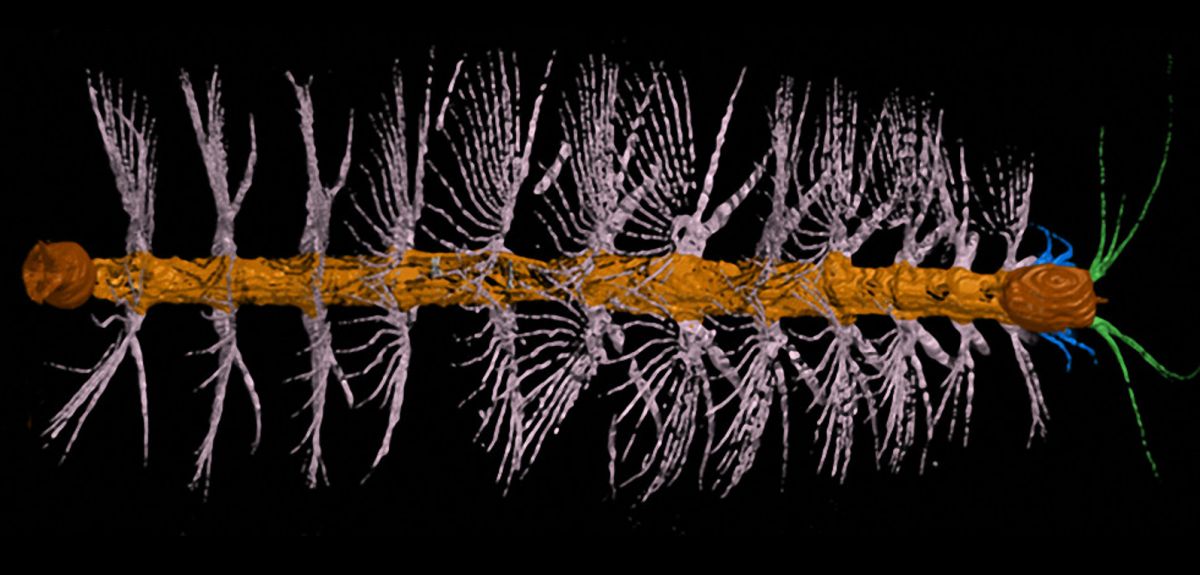
The 425-million-year-old 'bottle brush' beastie
Palaeobiologists at Oxford University have discovered a new fossil arthropod, christened Enalikter aphson, in 425-million-year-old rocks in Herefordshire. It belongs to an extinct group of marine-dwelling 'short-great-appendage' arthropods, Megacheira, defined by their claw-like front limbs.
Arthropods are a highly diverse family of invertebrates that include insects, arachnids and crustaceans, making up some 85 percent of all described animal species. The discovery and analysis of Enalikter aphson has given support to the notion that Megacheira came before the last common ancestor of all living arthropods in the tree of life. If correct, this would indicate that megacheirans were distant ancestors of all arthropods alive today.
Enalikter was just 2.4 centimetres long with a rounded rectangular head, no eyes and a curved, whip-like feature protruding from in front of its mouth that may have been used in feeding – for example to capture smaller marine invertebrates.
At the rear end of its stick-like body there were two pincer-like projections that were attached to a primitive 'tail', and which may have been used for defence against predators. The extinct arthropod had no hard shell but is nevertheless remarkably well preserved in a hard nodule of minerals comprised mainly of calcite. Professor Derek Siveter, lead author of the study from the Oxford University Museum of Natural History and Department of Earth Sciences, said: 'Enalikter aphson had a soft and flexible body so it is incredible that it survived. The nodule acted like a womb and kept the creature free from decay and destruction, which would normally have happened very quickly. It meant it was able to survive all the earth movements and history that have happened since.'
The researchers were able to reconstruct the specimen in 3D thanks to its perfect preservation in the nodule. The nodule was investigated by optical tomography, a technique that can be used to create digital reconstructions of 3D objects using a series of finely-spaced images. To reconstruct Enalikter, the researchers imaged sequential surfaces of the fossil, spaced a mere 20 microns – thousandths of a millimetre – apart. These numerous images were then edited on a computer, in places pixel by pixel, to identify true biological structures from background 'noise'.
'In 3D it looks a bit like a tiny bottle brush, or even a Christmas tree. It is beautiful,' said Professor Siveter. 'It has provided us with exceptional data for the fossil record. Its soft body shell, or cuticle, is less than 10 microns thick. It was organic but has not decayed. That is amazing. Such exceptional preservation represents the jewel in the crown of palaeontology and provides so much more information than what does the typical shelly fossil record. It offers a rare window on the marine community back then.'
The newly-discovered animal, described in the journal Proceedings of the Royal Society B, lived so long ago that the UK would have been south of the Equator near where the Caribbean islands are now.
'It would have lived on the seabed in water possibly up to about 100 or 200 metres deep, at a time known as the Silurian, when invertebrates were just beginning to move onto land,' said Professor Siveter. 'It would have been a very warm, subtropical environment.'
The Herefordshire site where the fossil was discovered has been a real treasure trove for Professor Siveter and colleagues for almost twenty years, providing valuable clues about what life on Earth was like in ancient times.
 Tamiflu: an analysis of all the data
Tamiflu: an analysis of all the data MeerKAT is shape of things to come
MeerKAT is shape of things to come How short is your time?
How short is your time?